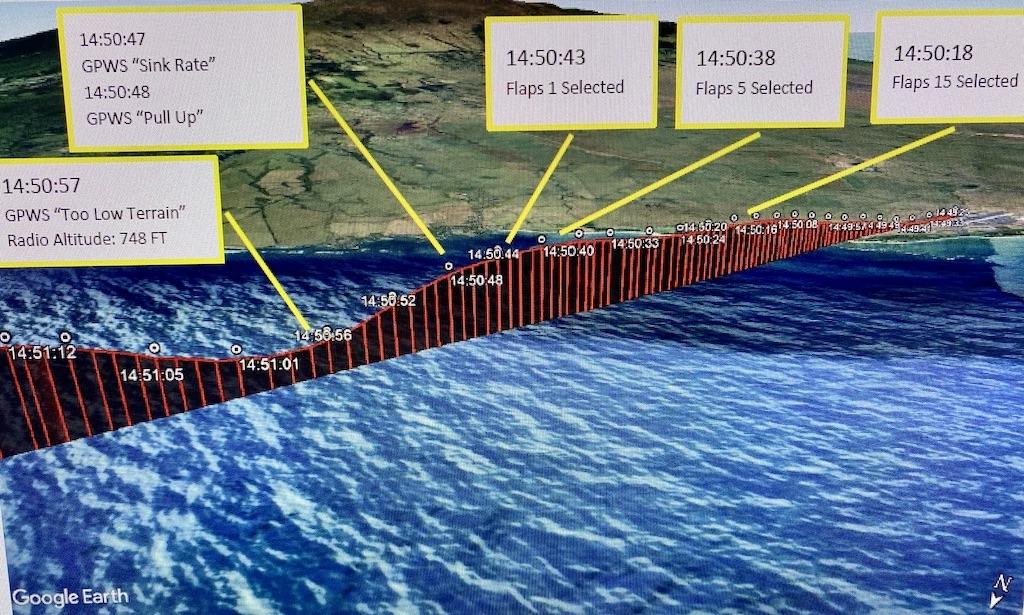
The ground track and altitude of example aircraft during the flap retraction distraction.
In the U.S. Air Force Military Airlift Command (now Air Mobility Command), there were rigid standards and they worked. We promoted 1,500-hr. pilots to aircraft commanders in C5s, albeit, their work was closely monitored for a time by very senior “co-pilots.”
But they did fine because we knew and they knew exactly what was expected. Still, as in any operation, distractions occurred.
In the corporate and airline world, there are strict policies and procedures for everything from takeoff and landing to how to serve hot beverages. When something doesn’t work out, we’re left with the question, what happened?
In each of the following incidents, one little distraction occurred that led to disaster or near disaster. I make no judgements here. These are human beings, just like me, trying just as hard as I did. They succumbed to a distraction, as we all have, but theirs didn’t go unnoticed.
Flap Setting Misunderstanding
From NTSB reports, a heavy jet takes off on a long international leg. Aircraft departs and starts initial climb normally, then loses half of its altitude, requiring a CFIT (Controlled Flight Into Terrain) max performance recovery.
The captain hand-flew the takeoff with the auto throttles engaged. During the takeoff, the rotation and initial climb were normal; however, as the airplane continued to climb, the flight crew noted airspeed fluctuations as the airplane encountered turbulence. When the airplane reached the acceleration altitude, the captain reduced the pitch attitude slightly and called for the flap setting to be reduced to flaps 5.
- Distraction: The first officer reduced the flaps to 15.
The captain noticed that the maximum operating speed indicator moved to a lower value than expected due to more flap being extended, and the airspeed began to accelerate rapidly, even in auto-throttle.
The captain reduced the engine thrust manually, overriding the auto throttle servos to avoid a flap overspeed and began to diagnose the flap condition. He noticed that the flap indicator was showing 15°, and he again called for flaps 5, and he confirmed that the first officer moved the flap handle to the 5° position.
The first officer stated that he “knew the captain was having difficulty with airspeed control,” and queried the captain about it as he considered if his own (right side) instrumentation may have been in error. He did not receive an immediate response from the captain. Both pilots recalled that, about this time, the airplane’s pitch attitude was decreasing, and the airspeed was increasing. The first officer recalled that that the captain asked for flaps 1 soon after he’d called for flaps 5, and when the first officer set the flaps to 1°, he noticed the airspeed had increased further, and the control column moved forward.
Both pilots recalled hearing the initial warnings from the ground proximity warning system (GPWS), and the first officer recalled announcing “pull up pull up” along with the initial GPWS warnings. The captain then pulled aft on the control column, initially reduced power to reduce airspeed, and then applied full power to “begin the full CFIT recovery.” The first officer recalled that, as the captain was performing the recovery, the GPWS alerted again as the descent began to reverse trend; data showed this occurred about 748 ft. above the water.
In a second incident, a flight crew with an inoperative APU reported that after an uneventful flight they elected to leave both engines running for the required two-minute engine cool down period and while ground power was being applied to the aircraft. As the airplane approached the gate, three ramp agents were present, but clear of the safety area. After stopping the aircraft and setting the parking brake, the captain gave the hand signal to connect the airplane to ground power.
As he was shutting down the number 2 (right) engine the message “DOOR CRG FWD OPEN” displayed on Engine Indicating and Crew Alerting System (EICAS). The co-pilot opened his window and yelled that the engines were still running.
The captain relayed his intentions to the first officer that the seat belt sign would stay illuminated until they had connected to ground power and could shut down the number 1 (left) engine. Immediately thereafter, he saw a warning light illuminate and the airplane shook violently followed by the immediate automatic shutdown of the number 1 engine.
Video surveillance captured the accident sequence and showed the airplane being marshalled to the gate. After the nose wheel was chocked, the ramp agent marshaling the airplane walked toward the forward cargo door located on the right side and near the front of the airplane.
Simultaneously, another ramp agent appeared walking toward the back of the airplane with an orange safety cone, where she disappeared from view. A third ramp agent located near the right wingtip could be seen gesturing with his hand toward the back of the airplane. Meanwhile, a fourth ramp agent knelt near the airplane’s nose wheel.
- Distraction: Somehow, two ramp agents were distracted from the fact that the engines were still running, as had been briefed. One opened the cargo door and one walked her normal path to the rear and then back forward.
The agent in the rear disappeared from view then reappeared walking along the leading edge of the left wing and directly in front of the number one engine. She was subsequently pulled off her feet and into the operating engine. The aircraft beacon operated throughout the course of the accident, indicating engines running.
The ground crew reported that a safety briefing was held about 10 minutes before the airplane arrived at the gate. A second safety “huddle” was held shortly before the airplane arrived at the gate, to reiterate that the engines would remain running until ground power was connected. It was also discussed that the airplane should not be approached, and the diamond of safety cones should not be set until the engines were off, spooled down, and the airplane’s rotating beacon light had been extinguished by the flight crew.
An airline flight crew just expected the plane to be behind them. Their radio calls demonstrate they didn’t change that expectation throughout the incident resulting in a tail strike, in Part 2 of this article.





